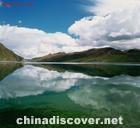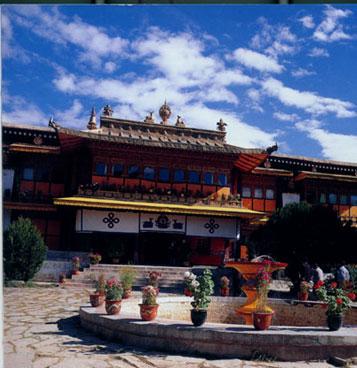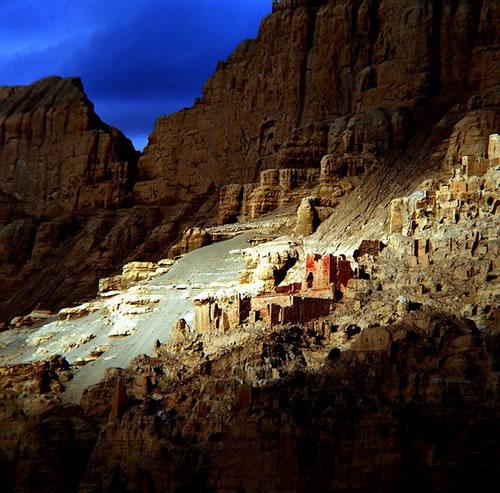
Overview
Lake Manasarovar (Mapham yum-tso; 4,556m), or Mapham Yum-tso (Victorious Lake) in Tibetan, is the the most venerated of Tibet's many lakes. According to ancient Hindu and Buddhist cosmology the four great rivers of the Indian su-continent, the Indus, Ganges, Sutlej and Brahmaputra, arise from Manasarovar.
In reality, only the Sutlej River originates at the lake, although the headwaters of the other great rivers are in close proximity. Just 20km from Mt Kailash across the Barkha plain, Manasarovar can be circumambulated in four or five days. Five of the original eight monasteries in the area have been partially rebuilt.
Know more
Manasarovar is linked to the smaller lake Rakshas Tal (also known as Lhanag-tso) by a channel called Ganga-chu. On rare occasions, water flows via this channel from Lake Manasarovar to Rakshas Tal; this is said to augur well for the Tibetan people. The channel had long been dry, but water has indeed been flowing between the two lakes in recents years. The two bodies of water are associated with the conjouned sun and moon, a powerful symbol of Tantric Buddhism.
The Buddhists believe that the lake is the bestowal from the heaven. Lake Manasarovar represents the female or wisdom adpect of enlightenment, and is a symbol of good fortune and fertility. While Mt Kailash stands fully revealed, the depths of Lake Manasarovar are hidden from view to all but the greatest of adepts.
After walking around the lake and taking baths at the Four Bathing Gates, the pilgrims can be free from sins and be bestowed happiness.The great monk Xuan Zhuang praised it "the Holy Lake in the West Heaven". Not far from the lake stands Mt. Holy (Kailash). The route alternates between sandy, gravelly and marshy ground. Manasarovar is often a gem-like cobalt colour but during storms it can turn into a churning black sea. High elevation lends it a radiance unmatched by lower lakes and its fresh waters are as clear as can be.
Must see
Mt Kailash

The 52km circuit of Mt Kailash (6,714m) is one of the most important pilgrimages in Asia. A religious sanctuary since pre-Buddhist times, a trek here wonderfully integrates the spiritual, cultural and physical dimensions of a trip to Tibet, which explains its growing attraction. The well-trodden track around the sacred mountain passes through verdant alpine valleys linked by a lofty pass, the Drolma-la. Being able to meet pilgrims from across Tibet and other countries is one of the many allures of this walk.
Chiu Monastery

33km south of Darchen and 8km south of the main highway, Chiu Monastery enjoys a fabulous location atop a craggy hill overlooking the sapphire blue Lake Manasarovar. The chape here contains images of Sakyamuni (Sakya Thukpa) and Guru Rinpoche. Climb up to the roof of the monastery for stunning views of the lake. The huge peak on the southern horizon is 7,728m Gurla Mandata, near the border with Nepal.
There are hot springs behind the monastery, and a small glass-roofed bathhouse close to the village. The water is channelled from the hot springs into individual cubicles via open ducts and it's barely likewarm by the time you can get a few centimetres of water into the mouldy tiled tubs. You can also do your laundry in the warm outflow around the back.
Guge Kingdom

Tholing and neighbouring Tsaparang are the ruined former capitals of the ancient Guge kingdom of Nagri, accessed via the modern Chinese town of Zanda (also known as Thsasda or Zhada). Tsaparang, in particular, is a truly amazing sight, in part because it is so little known. The 9th-century ruins are carved into the steep sides of an imposing ridge. Cave dwellings, stunning monastic buildings and a ruined palace are linked by twisting paths and secret tunnels that worm their way into the rock itself.
This barren landscape seems an unlikely place for a major civilisation to have developed; yet the Guge Kingdom thrived as an important stop on the trade route between India and Tibet. By the 10th century it was a wealthy centre supporting several thousand people, and the great Guge King Yeshe O began to nurture an exdhange of ideas between India and Tibet. ...more
